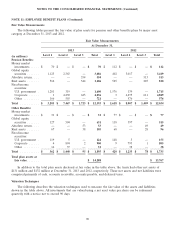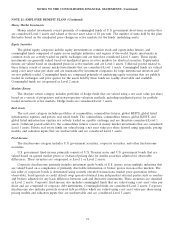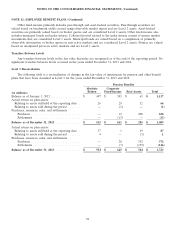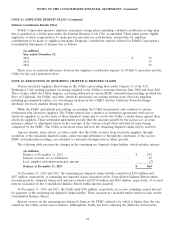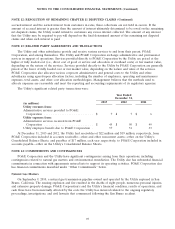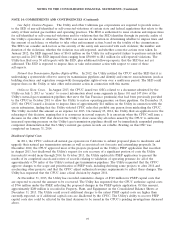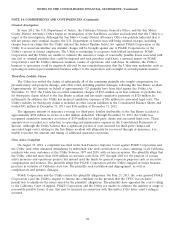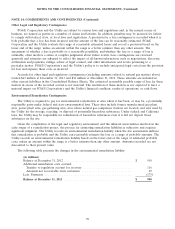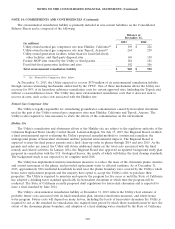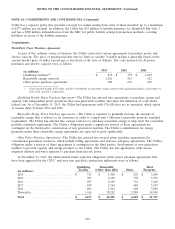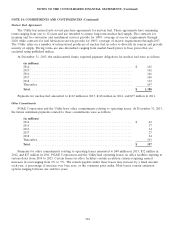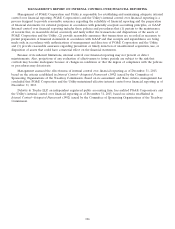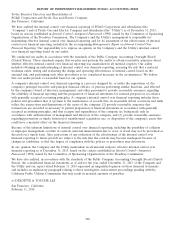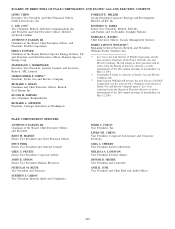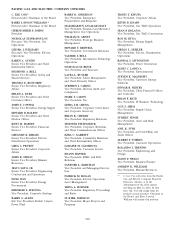PG&E 2013 Annual Report Download - page 106
Download and view the complete annual report
Please find page 106 of the 2013 PG&E annual report below. You can navigate through the pages in the report by either clicking on the pages listed below, or by using the keyword search tool below to find specific information within the annual report.
NOTES TO THE CONSOLIDATED FINANCIAL STATEMENTS (Continued)
NOTE 14: COMMITMENTS AND CONTINGENCIES (Continued)
The environmental remediation liability is primarily included in non-current liabilities on the Consolidated
Balance Sheets and is composed of the following:
Balance at
December 31,
2013 2012
(in millions)
Utility-owned natural gas compressor site near Hinkley, California(1) $ 190 $ 226
Utility-owned natural gas compressor site near Topock, Arizona(1) . . 264 239
Utility-owned generation facilities (other than for fossil fuel-fired),
other facilities, and third-party disposal sites ................ 160 158
Former MGP sites owned by the Utility or third parties .......... 184 181
Fossil fuel-fired generation facilities and sites ................. 102 106
Total environmental remediation liability .................... $ 900 $ 910
(1) See ‘‘Natural Gas Compressor Sites’’ below.
At December 31, 2013, the Utility expected to recover $579 million of its environmental remediation liability
through various ratemaking mechanisms authorized by the CPUC. One of these mechanisms allows the Utility rate
recovery for 90% of its hazardous substance remediation costs for certain approved sites (including the Topock site)
without a reasonableness review. The Utility may incur environmental remediation costs that it does not seek to
recover in rates, such as the costs associated with the Hinkley site.
Natural Gas Compressor Sites
The Utility is legally responsible for remediating groundwater contamination caused by hexavalent chromium
used in the past at the Utility’s natural gas compressor sites near Hinkley, California and Topock, Arizona. The
Utility is also required to take measures to abate the effects of the contamination on the environment.
Hinkley Site
The Utility’s remediation and abatement efforts at the Hinkley site are subject to the regulatory authority of the
California Regional Water Quality Control Board, Lahontan Region. On July 17, 2013, the Regional Board certified
a final environmental report evaluating the Utility’s proposed remedial methods to contain and remediate the
underground plume of hexavalent chromium and the potential environmental impacts. The Regional Board is
expected to issue the final project permits and a final clean-up order in phases through 2014 and into 2015. As the
permits and order are issued, the Utility will obtain additional clarity on the total costs associated with the final
remedy and related activities. In January 2014, the Regional Board also approved an updated background study plan
prepared in consultation with the U.S. Geological Survey, the results of which will define the final cleanup standards.
The background study is not expected to be complete until 2018.
The Utility has implemented interim remediation measures to reduce the mass of the chromium plume, monitor
and control movement of the plume, and provided replacement water to affected residents. As of December 31,
2013, approximately 380 residential households located near the plume boundary were covered by the Utility’s whole
house water replacement program and the majority have opted to accept the Utility’s offer to purchase their
properties. The Utility is required to maintain and operate the program for five years or until the State of California
has adopted a drinking water standard specifically for hexavalent chromium at which time the program will be
evaluated. The State of California recently proposed draft regulations for hexavalent chromium and is expected to
issue a final standard by June 2014.
The Utility’s environmental remediation liability at December 31, 2013 reflects the Utility’s best estimate of
probable future costs associated with its final remediation plan, interim remediation measures, and whole house
water program. Future costs will depend on many factors, including the levels of hexavalent chromium the Utility is
required to use as the standard for remediation, the required time period by which those standards must be met, the
extent of the chromium plume boundary, and adoption of a final drinking water standard by the State of California.
100


